 Archaeologists from France’s National Institute for Preventative Archaeology (INRAP) have unearthed an ancient Roman sanctuary dedicated to the God Mithras in Lucciana on east coast of Corsica. This is an exceptionally rare found as it is the first mithraeum ever discovered in Corsica, and only a dozen have been found in all of France.
Archaeologists from France’s National Institute for Preventative Archaeology (INRAP) have unearthed an ancient Roman sanctuary dedicated to the God Mithras in Lucciana on east coast of Corsica. This is an exceptionally rare found as it is the first mithraeum ever discovered in Corsica, and only a dozen have been found in all of France.
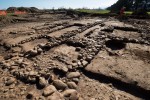 The site was excavated by INRAP in advance of roadwork planned in the neighborhood. The remains of the ancient city of Colonia Mariana are within the municiple boundaries of Lucciana, but this particular area had not been excavated before. It would have been a peripheral sector of the Roman town, and the remains of modest homes and artisan workshops found in the excavation confirmed that it was a working class neighborhood.
The site was excavated by INRAP in advance of roadwork planned in the neighborhood. The remains of the ancient city of Colonia Mariana are within the municiple boundaries of Lucciana, but this particular area had not been excavated before. It would have been a peripheral sector of the Roman town, and the remains of modest homes and artisan workshops found in the excavation confirmed that it was a working class neighborhood.
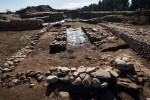 The team began the archaeological survey in November of last year. In the three months since, archaeologists have found the worship room of the mithraic sanctuary and an antechamber. The main hall is a rectangle about 36 feet by 16 feet in dimension. It has a central nave with two long benches going down its length. The benches are six feet wide. A vaulted brick niche was built into
The team began the archaeological survey in November of last year. In the three months since, archaeologists have found the worship room of the mithraic sanctuary and an antechamber. The main hall is a rectangle about 36 feet by 16 feet in dimension. It has a central nave with two long benches going down its length. The benches are six feet wide. A vaulted brick niche was built into 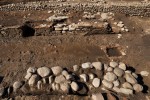 each bench taking up the full thickness of the banquette. They were positioned opposite each other, and one of the niches contained three intact oil lamps. This was how the sanctuary was lit.
each bench taking up the full thickness of the banquette. They were positioned opposite each other, and one of the niches contained three intact oil lamps. This was how the sanctuary was lit.
Other artifacts recovered from the site include a marble head of a woman, a marble foot, pottery, two bronze bells, numerous broken lamps and glass paste jars that may have  been liturgical furnishings. Two inscribed plaques, one of bronze, one of lead, were found; the inscriptions have yet to be deciphered. Three fragments of a marble bas-relief are of particularly significance because while some of the carving is missing, it is still recognizable as the tauroctony, the iconic scene of Mithras slaying the sacred bull while a dog and snake drink its blood and a scorpion stings its testicles.
been liturgical furnishings. Two inscribed plaques, one of bronze, one of lead, were found; the inscriptions have yet to be deciphered. Three fragments of a marble bas-relief are of particularly significance because while some of the carving is missing, it is still recognizable as the tauroctony, the iconic scene of Mithras slaying the sacred bull while a dog and snake drink its blood and a scorpion stings its testicles.
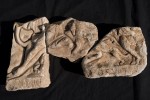 The Persian deity Mithra inspired the religion, but the version that spread throughout the Roman Empire starting in the 1st century A.D. bears little religion to the original. The mystery religion is believed to have been brought west by Roman soldiers and spread from military bases and ports. From what we can tell — there are no written records of the faith — it was only open to men and was particularly popular with soldiers. What we know of Mithraism has been gleaned from archaeological remains, mainly artifacts and art depicting myths and rituals.
The Persian deity Mithra inspired the religion, but the version that spread throughout the Roman Empire starting in the 1st century A.D. bears little religion to the original. The mystery religion is believed to have been brought west by Roman soldiers and spread from military bases and ports. From what we can tell — there are no written records of the faith — it was only open to men and was particularly popular with soldiers. What we know of Mithraism has been gleaned from archaeological remains, mainly artifacts and art depicting myths and rituals.
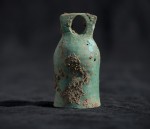 The Roman city of Colonia Mariana, was founded around 100 B.C. by Roman general, military reformer and seven-time consul Gaius Marius. He and his one-time friend and colleague turned nemesis Lucius Cornelius Sulla, each founded a colony in Corsica (Sulla’s was Aleria) which they seeded with their veterans. Mariana was an important center in Roman Corsica, thanks largely to its commercial harbor that was a hub of maritime trade on the Mediterranean. The patron saint of Corsica and of the Principality of Monaco, Saint Devota, was born in Mariana in the late 3rd century and was martyred there in 303 A.D. Her martyrdom inspired many a conversion and by the end of the century Mariana was solidly Christian. The Diocese of Mariana was created in 4th or early 5th century, one of the first Christian dioceses in Corsica.
The Roman city of Colonia Mariana, was founded around 100 B.C. by Roman general, military reformer and seven-time consul Gaius Marius. He and his one-time friend and colleague turned nemesis Lucius Cornelius Sulla, each founded a colony in Corsica (Sulla’s was Aleria) which they seeded with their veterans. Mariana was an important center in Roman Corsica, thanks largely to its commercial harbor that was a hub of maritime trade on the Mediterranean. The patron saint of Corsica and of the Principality of Monaco, Saint Devota, was born in Mariana in the late 3rd century and was martyred there in 303 A.D. Her martyrdom inspired many a conversion and by the end of the century Mariana was solidly Christian. The Diocese of Mariana was created in 4th or early 5th century, one of the first Christian dioceses in Corsica.
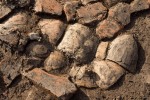 It’s possible the rise of Christianity in Mariana came in direct conflict with the worship of Mithras. Emperor Theodosius I made Christianity the official religion of the Empire in 392 and outlawed all pagan religions, including Mithraism. Some of the objects found in the Mariana sanctuary were damaged in antiquity, most notably the altar, and the sanctuary itself appears to have been deliberately destroyed and filled with rubble. A large Paleochristian church and baptistery complex was built in the city around 400 A.D., the first archaeological traces of Christianity in Corsica. There were likely tensions between the adherents of the religions.
It’s possible the rise of Christianity in Mariana came in direct conflict with the worship of Mithras. Emperor Theodosius I made Christianity the official religion of the Empire in 392 and outlawed all pagan religions, including Mithraism. Some of the objects found in the Mariana sanctuary were damaged in antiquity, most notably the altar, and the sanctuary itself appears to have been deliberately destroyed and filled with rubble. A large Paleochristian church and baptistery complex was built in the city around 400 A.D., the first archaeological traces of Christianity in Corsica. There were likely tensions between the adherents of the religions.
‘Tauroctony’ looks rather weird to me, and isn’t there in theory a single bull involved, i.e. not ‘eight’ or whatever ?
In Greek, there is κτάντης (murderer) and the verb κτείνω (kill, slay). The Tauros receives a τόμος (cut).
Therefore, what I would like to suggest here, would either be a tauroktomy, taurokteny or tauroktany 😆
Tauroctony is from the Greek tauroktonos (ταυροκτόνος) which means “bull killing.”
Thanks Liv, I have to admit that in addition to κτάντης (=murderer), I now found κτόνος (=murder). However, I never saw police reports about ‘murderations‘ 😮 – Apparently, ‘Tauroctony’ is some form of neologism.